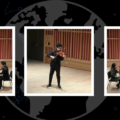This month on Planet Classroom, the Bard College Conservatory of Music presents Lars-Erik Larsson’s Concertino for Trombone and String Orchestra, featuring renowned trombonist Weston Sprott.
Introduced by Henry Shankweiler, this mesmerizing performance combines poetic narration with stunning classical harmonies. Showcasing the exceptional talent of Bard’s musicians, this short film offers an unforgettable exploration of Larsson’s musical world.
Curated by the Bard College Conservatory of Music, this performance highlights the artistry of Weston Sprott, who is Dean and Director of the Preparatory Division at The Juilliard School, Co-Founder of the Black Orchestral Network, and a trombonist in the Metropolitan Opera Orchestra.
The Global Search for Education is pleased to welcome Weston Sprott.
Weston, Lars-Erik Larsson’s Concertino for Trombone and String Orchestra blends poetry with music in a way that invites introspection. As a performer, how do you balance the technical demands of the trombone with the interpretive artistry required to evoke the poetic essence of the piece?
Playing any piece well is a matter of overcoming technical and musical demands and fusing those solutions together seamlessly. For example, the first movement is structured entirely as a cadenza. Beyond its technical challenges, the goal is to craft phrases that evoke a sense of rhythmic freedom and spontaneity, juxtaposing boldness and introspection. To achieve this, I consider the musical tools at my disposal—tempo, tone color, dynamics, articulation, vibrato—and how to manipulate them to create the desired feeling. It’s not enough to simply feel excitement; I must automate the techniques that produce excitement and layer them to achieve the desired emotional and artistic result.
Your collaborations span some of the world’s finest orchestras and ensembles. How did your experience shape your approach to working with Bard’s musicians on Larsson’s Concertino, and what insights did you aim to impart to the students involved?
Whether I’m playing with a renowned orchestra or an ensemble of students, I always aim to give my best. So much of what we communicate is who we are, how we approach our work, and how we treat others. This performance was given in November during the challenging environment of the COVID-19 pandemic. Playing the trombone with a mask and a bell cover in front of a socially-distanced orchestra was far from comfortable, but we collectively overcame these obstacles with joy. I hope the students took away the belief that difficult circumstances shouldn’t stop us from making music and sharing it with others.
Larsson’s Concertino is often described as both accessible and profound. As a soloist and educator, how do you navigate the challenge of presenting a work that simultaneously speaks to classical music aficionados and first-time listeners?
For many listeners, this might have been the first time they’d heard Larsson’s Concertino or even a trombone concerto at all. Many concertos aim to showcase the technical and emotional range of the instrument. With this piece, I hope listeners leave with a greater appreciation for the lyrical qualities of the trombone in the first two movements and an understanding of its agility and velocity in the third.
Thank You, Weston!
C. M. Rubin with Weston Sprott
Don’t miss Lars-Erik Larsson’s Concertino for Trombone and String Orchestra, now streaming on the Planet Classroom Network. This performance is curated by Bard College Conservatory of Music.







Recent Comments